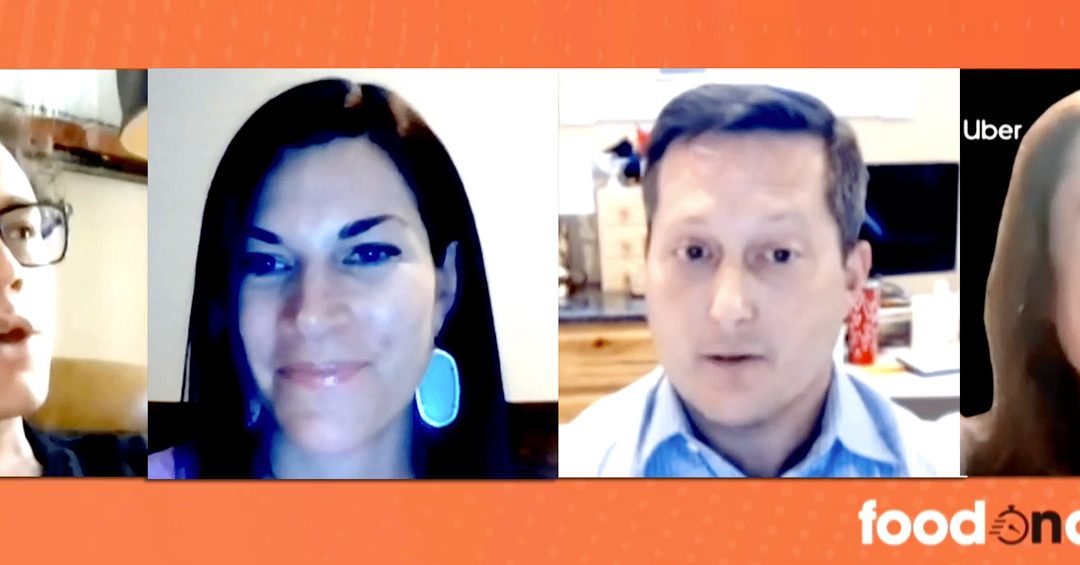In the hour-long Deep Dive panel during the Food On Demand Conference, leaders within the four major third-party networks shared some critical insights about the space.
To see the whole panel and soak up all everything they discussed as well as many other great panels, head over to the conference page to watch the recorded sessions (registration required) or see our conference coverage here.
There was a lot to cover but how things have evolved through the COVID-19 pandemic was a top topic and there were a lot of learnings as the industry muscled through the historic shift in business.
All the brands noted an explosion in order activity. According to Grubhub senior director of enterprise Liz Bosone, many markets doubled in order volume, but some big markets were hammered even after everything stopped back in March.
“All of our non-New York markets experienced a growth surge, and many were up 100 percent year-over-year. But New York it is our largest consumer market, obviously it was very impacted by COVID. We did see a bigger decline there. We had partners opt to close instead of stay open and have a fraction of business. We’re seeing restaurants open back up, but orders are still impacted in New York,” said Bosone.
She said one of the best things is brands are leaning into convenience more than ever, and it’s become a net positive for the platform drivers, customers and restaurants. The drive thru has especially gotten some more attention. Typically, QSR are extremely protective of any changes to the drive-thru, but not anymore. She said brands are warming to the possibility of handing delivery orders out the drive-thru window.
“I think brands have had to become more comfortable with that concept, prior to COVID we didn’t have any brands that were doing that outside of late-night hours, but we’re seeing more brands adapt to that,” said Bosone.
One key learning is the big changes like adding groceries and meal kits to the mix was a nice idea, but it didn’t really get much traction after those initial chaotic days, as Craig Whitmer VP of merchant business development at Postmates.
“We saw some OK success; we saw some bigger basket size. But the data I have seen, it didn’t really take off,” said Whitmer. “I don’t see that being a long-term trend. We even had some wholesalers doing food delivery, and that wasn’t that big either.”
He said ticket sizes overall did grow, even as lower-ticket brands jumped onto the platform.
“We saw a big increase in QSRs a lot of these folks we were talking to, all that accelerated really fast and became a bigger mix and those tend to be smaller basket sizes,” said Whitmer.
He said the company had a five percent bump in orders over $50 and a five percent reduction in orders under $20.
“That shows people are spending more money and they’re buying more frequently,” said Whitmer.
He noted a 15 percent growth in consumers with kids, so a lot more family meals are getting delivered and that continues even as things slowly crawl back to normal.
The big learning is restaurants with digital sales channels beyond the platforms outperformed those without dramatically.
“One of the most interesting things we saw was the restaurants with their own white label capabilities were able to respond much faster and saw the opportunity to drive sales inclusive of the marketplace, they could drive sales with their customers,” said Toby Espinoza VP of business development at DoorDash.
That might sound obvious, reaching customers via your own channels and directing them to your menu is always a nice-to-have. But when COVID-19 hit and customers were eager to help out, scores of restaurants had few options.
“We found that only 40 percent of our own partners had their own e-commerce platform. So, we immediately built our DoorDash storefront so any partner of any size could use that as an e-commerce system,” said Espinoza.
That key point was reinforced over and over, and restaurant operators agreed that e-commerce went from a nice-to-have to absolutely essential in the past six months. It’s something Uber enterprise director of partnerships Kelly Seeman saw in a survey the company did with Technomic.
“I think what was helpful was just that the restaurants saw increased sales by partnering with delivery platforms—84 percent said they reached customers that they would not have reached without these partnerships,” said Seeman. “Seventy six percent said they might have had to close their doors without this Uber Eats partnership. That I don’t take lightly. Knowing that we’re able to help businesses stay afloat makes me and my whole team at Uber Eats feel good about what we’re doing.”
In all, 92 percent said they would continue to work with third-party platforms through this new normal and beyond.
Seeman said the company also saw the desire for more tools to oversee the channel as it became the dominant channel for many restaurants.
“We launched a new mobile app to help managers stay on top of sales on their phone. We all want to see the money right away when it hits,” said Seeman. “We also noticed a need for restaurant managers to respond to customer comments quickly.”
She said she thought that would be something independent owners used, but it popped up in the board room when CAVA CEO Brett Schulman said he used the app all the time.
If you want to see the whole panel or the rest of the 2020 Food On Demand Conference, head to the conference page (registration required) or keep up with our ongoing conference tidbits here.


